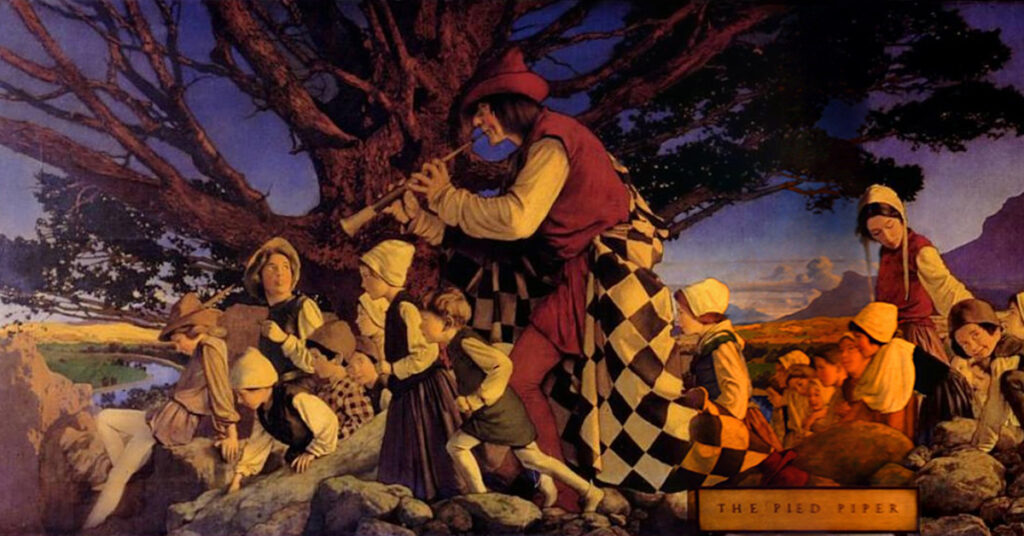
The Pied Piper story holds a dark secret that has repelled and fascinated us for over 500 years. It asks, “What does it cost to banish our shadow?”
At its surface, it looks like a simple morality tale cautioning us to be prudent and fair. Rats overrun a town, and the locals are beside themselves. A magical piper vibrantly dressed offers a solution too good to be true. His pipe weaves a tune that leads rats to their doom – and they drown in the ocean so neatly. Thrilled at first, then cunning and foolish, the town leaders refuse to pay the piper for his service. In turn, he entrances all but three children and takes them away forever.
Historians wonder if the account is an artifact of a devastating plague. The Lueneburg manuscript from about 1440 CE records the following event: “In the year of 1284, on the day of Saints John and Paul on June 26, by a piper, clothed in many kinds of colours, 130 children born in Hamelin were seduced, and lost at the place of execution near the koppen.” But tragedy was common in the middle ages, and death a constant companion, so why has this account remained vital?
The enduring interest in the Pied Piper lies in its symbolic resonance with psyche. When we place the events in our imaginal world, our curiosity is liberated, and our questions become more interesting. What are the pestilential rats inside us? What happens when we ask another person to solve our inner problems? How does the unconscious react when we trick and devalue the inner and outer figures who help us along our way?
Rats populate our inner and outer world. We use them as pharmacological proxies and share about 69% of the same DNA. We keep them as pets even as others work tirelessly to exterminate them from our buildings. In some cultures, they represent prosperity and are tended to as the reincarnation of family members. But foremost, they are survivors and adaptors living side by side in every human endeavor.
We project much shadow on rats accusing them of spreading disease and taking our food without permission – those ratfinks. They hold our unsavory instincts; like all shadow-invested objects, we want them gone! But why are we thankless when someone helps us achieve that? Freud’s Taboo insights suggest anyone associated with our ‘filth’ becomes impure, so degrading them engenders relief.
Complications with money play another part. We’re quick to promise payment when our need is aroused but grim when it’s time to write the check – our mounting credit card debt bears witness to that. Paying the piper evokes dread when we fail to imagine the complete cycle of exchange, and our inner infant is indignant being charged for restoring comfort. Shouldn’t it be free?!? We project our psyches into money and use similar terms for its fluctuations – inflation, depression, and devaluation. Handing over our cash feels like we’re sacrificing an inner potential, surrendering it to our creditors.
This may be a key that unlocks the fairytale.
Perhaps it’s warning us that there’s a cost to banishing our shadow. Strangely, rats, money, and children carry a similar symbolic valence. They all suggest unrealized potential. The vitality in our rat-shadow could have fueled a midlife renewal. Money could have turned our desires into realities. And our children could have carried our hopes into the future.
Perhaps demonizing any aspect of our potential puts all of it at risk, and banishing it to the unconscious may trigger strange, irresistible compulsions that can lead us astray.
~ Joseph R. Lee
HERE’S THE DREAM WE ANALYZE:
“A party with colleagues ends. I settle down with a male and a female colleague to watch a film on a large and comfortable sofa. It’s starring the Japanese actress Meiko Kaji. The opening shot is of a large, grand Hotel-like building in Japan. It’s angular, with black and gold detailing and a Frank Llyod-Wright-like feel, suggesting the film’s setting is around the 1920s. The hotel seems to be more like a luxurious mental institution. Meiko Kaji plays an inmate of this institution, and she seems to be held there somewhat against her will. A shot looking down from a mezzanine into the main hall shows the heroine defiantly resisting her treatment, dressed in an ornate nightgown of white lace. She faces off sullenly against the institution’s manager, a diminutive Japanese man in a tuxedo (he looks more like a hotel manager). She floods the hall with a shallow inpouring of seawater. The manager is highly perturbed by the woman’s display of emotion and disobedience. It’s clear that this institution doesn’t know how to treat this woman. Within the hall, a large letter in an ornate frame, similar to the style of the building, is displayed, written in Japanese. It’s a letter mandating the woman’s treatment. The film continues, and we learn more about the source of the woman’s troubles. She lost a child. She allies with another inmate, a similarly white-attired younger woman. The two of them resolve to escape the institution to resolve the issue of the lost child, setting out for the “Place of Lost Children.” The Place of Lost Children is in the heart of a forest, an industrial wasteground. The younger woman holds a lantern to light the way. The ground is littered with dead children, all alike – they’re wrapped in bright red shawls, completely concealing their bodies, the face of each covered with a blank theatrical mask. The younger woman moves around the bodies, removing the masks to try and identify the older woman’s lost child. Every child has the same face, a cartoonish face that I recognize – Pug, from the comic strip “The Bash Street Kids.” I think, “this is a face that not even a mother could love.” As I watch the film, I remark to myself, “this depiction is not very realistic. But it would be too horrible to look at if it was more realistic.” The women continue the search but in vain. They discover the missing child is at the bottom of a dark, black pool nearby. The child has dissolved, leaving an image on the water’s surface. It’s very similar to Pug but more disfigured – the face and eyes are scarred. The film ends, and I’m back in the comfortable lounge. An older man is present, about fifty or so, looks confident, successful, an entrepreneur or self-made man of some sort, a man who plays golf. He’s telling me with great excitement about how he used to know the actress in his youth, singing her praises. Were they lovers? A notice that my father has appeared. He’s listening intently to the man as well. The man shows me an illustrated memoir that he’s working on, partly about the woman and his life in general. I’m surprised by the man’s artistic zeal – he seems more like the practical type. The artwork is that of a beginner, but it’s clearly powered by something genuine. He shows me the last page, painted very thickly with oil paints that are still wet. He tries to explain it to me, but it’s difficult. In a final effort to make me understand, he gathers up the wet paint with his fingers into a shape. It resembles Uluru/Ayer’s rock.”
BECOME A DREAM INTERPRETER
We’ve created DREAM SCHOOL to teach others how to work with their dreams. A vibrant community has constellated around this mission, and we think you’ll love it. Check it out.
PLEASE GIVE US A HAND
Hey folks — We need your help. Please BECOME OUR PATRON and keep This Jungian Life podcast up and running.
SHARE YOUR DREAM WITH US
SUBMIT YOUR DREAM HERE FOR A POSSIBLE PODCAST INTERPRETATION.
FOLLOW US ON SOCIAL MEDIA
FACEBOOK, INSTAGRAM, LINKEDIN, TWITTER, YOUTUBE
INTERESTED IN BECOMING A JUNGIAN ANALYST?
Enroll in the PHILADELPHIA JUNGIAN SEMINAR and start your journey to become an analyst.

0 Comments